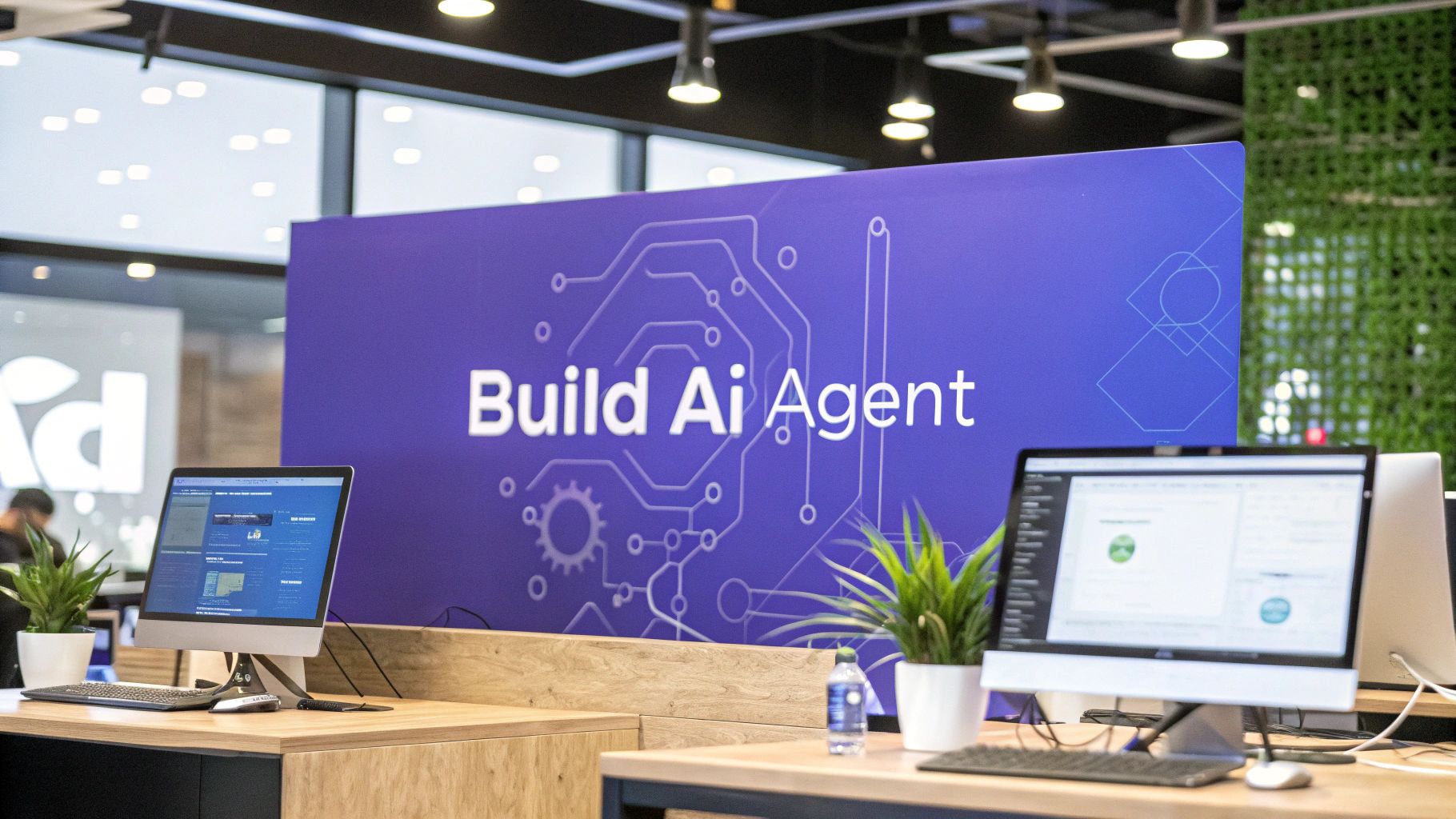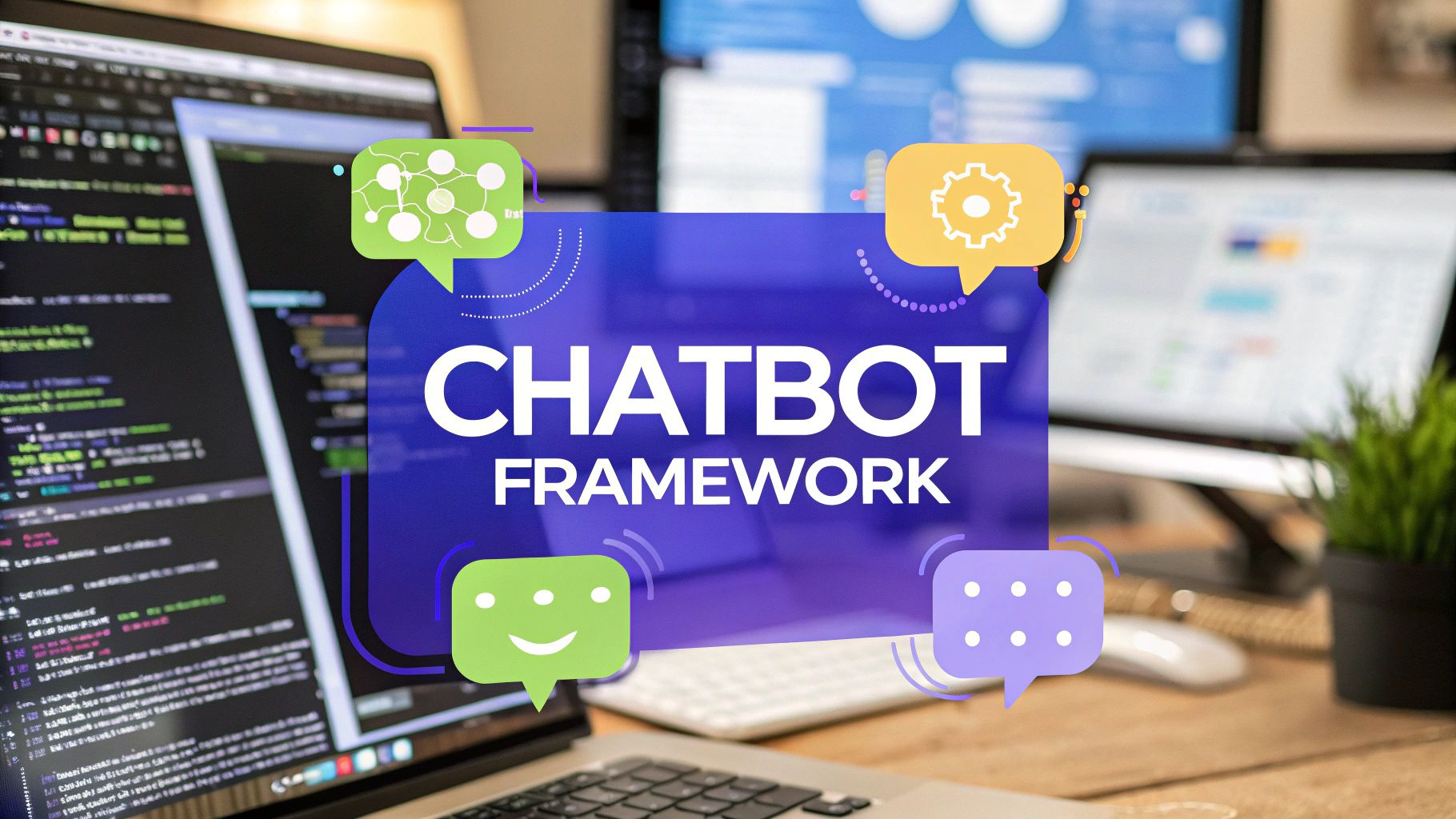Unlocking Helpdesk Artificial Intelligence
Discover how helpdesk artificial intelligence streamlines support, boosts agent productivity, and enhances user satisfaction. Learn how to implement AI today.
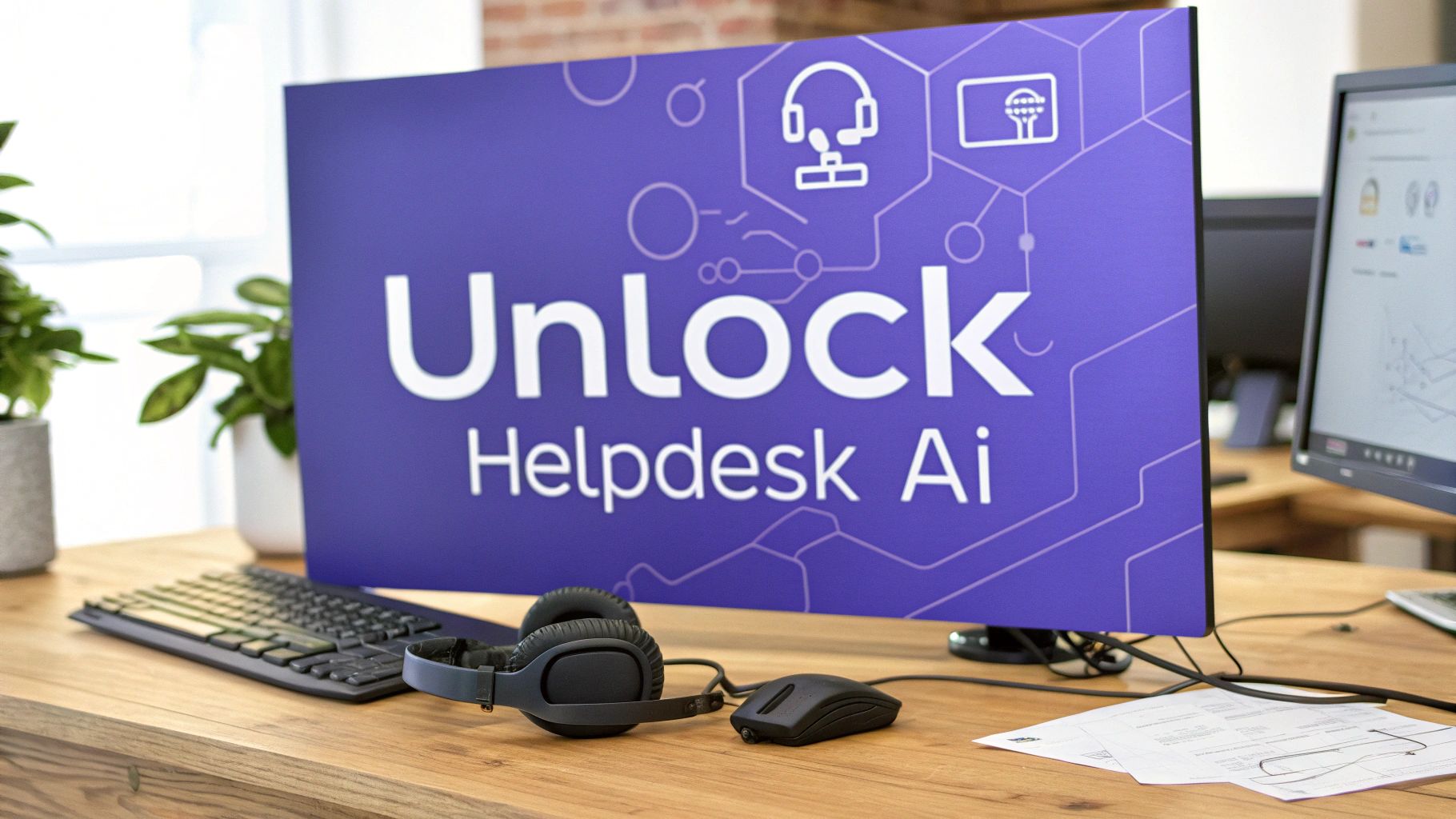
Let's be honest, most of us have felt that sinking feeling when we have a problem and have to contact a helpdesk. We brace ourselves for long waits, repeating the same information, and hoping we get someone who can actually fix the issue.
But what if that entire experience was different? What if the helpdesk was smart, fast, and could anticipate what you needed before you even finished typing? That's exactly where helpdesk AI comes in.
It's not about replacing humans with robots. Instead, it uses technologies like machine learning and natural language processing to handle the repetitive, time-consuming tasks that clog up support queues. This frees up human agents to focus on what they do best: solving complex problems that require a human touch.
What Is Helpdesk AI and Why It Matters Now
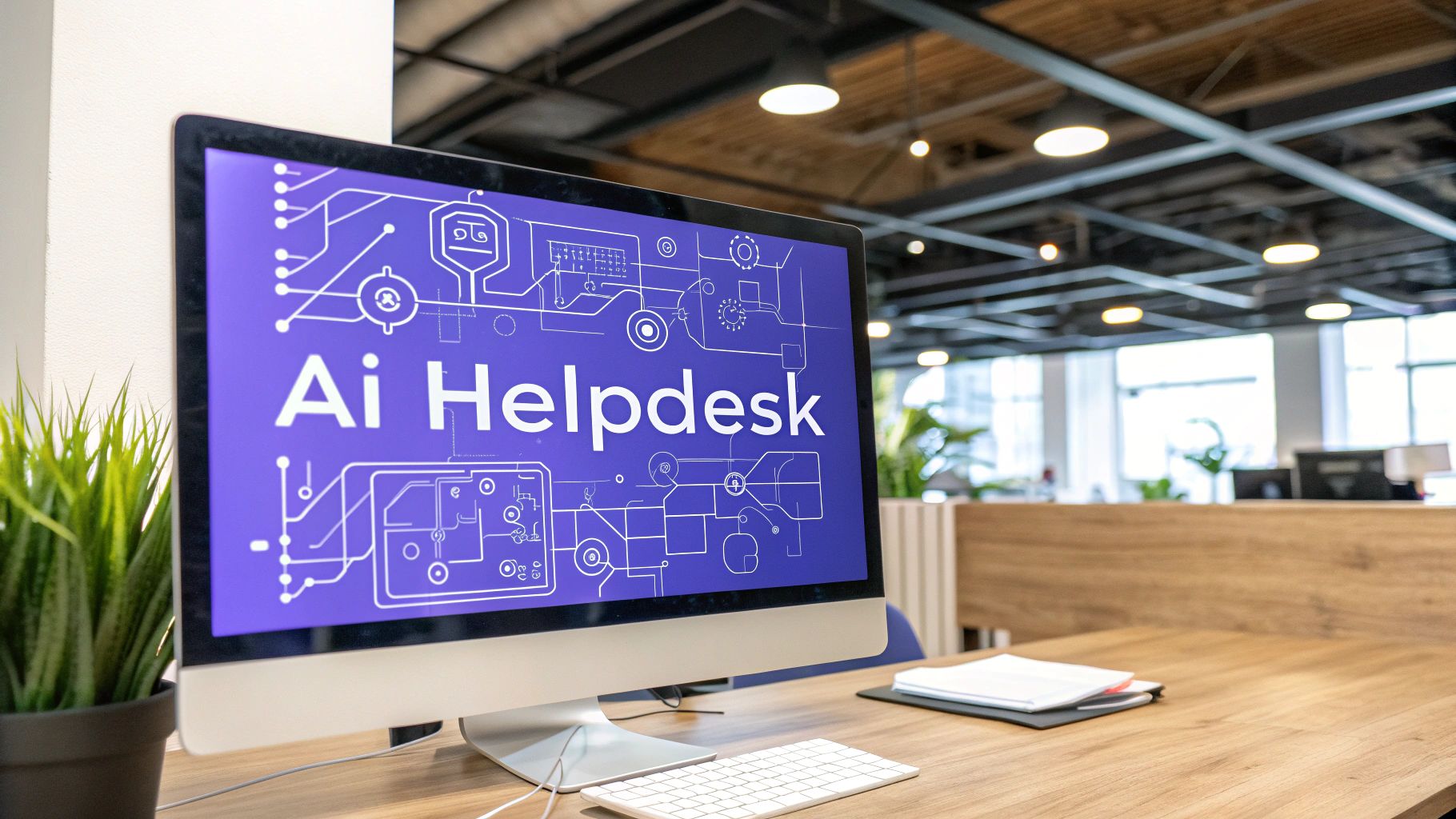
Think of a traditional helpdesk like a manual telephone switchboard. A call comes in, the operator listens, tries to figure out who can help, and then physically connects the line. It's slow, prone to mistakes, and completely reliant on that one person's availability. If they're swamped or it's after hours, you're out of luck.
Now, imagine helpdesk artificial intelligence as a brilliant digital assistant working alongside that operator. This assistant doesn't just route calls; it understands them. It can answer common questions instantly, troubleshoot basic issues on its own, and knows exactly when to pass a tricky problem to a human expert. It works 24/7, learns from every single interaction, and gets smarter over time.
This isn't just a minor upgrade. It’s a fundamental change in how businesses approach customer and employee support.
The Shift From Cost Center to Strategic Asset
For years, helpdesks have been seen as a necessary evil—a cost center you have to fund just to put out fires. An AI-powered helpdesk, on the other hand, is a strategic asset that actively drives efficiency, boosts satisfaction, and saves a significant amount of money.
The numbers don't lie. By 2027, the market for IT helpdesk automation is expected to hit nearly $22 billion. This growth is happening for a simple reason: manual support is expensive. A single support call can cost anywhere from $20 to $100. And when you realize that about 22% of all helpdesk calls are for simple password resets—each costing around $22—the value of automation becomes crystal clear. You can find more insights on the rising costs of traditional IT support over on Atera.com.
Helpdesk AI isn’t about replacing humans; it’s about augmenting them. It handles the repetitive, high-volume tasks so your skilled agents can focus on complex, high-value problem-solving that requires critical thinking and empathy.
Let's look at the key differences in a bit more detail.
Traditional Helpdesk vs AI-Powered Helpdesk
This table breaks down the core operational differences between a standard, manual helpdesk and one enhanced with AI. It really highlights the shift from a reactive model to a proactive, intelligent one.
As you can see, the move to an AI-powered helpdesk isn't just about efficiency; it's about fundamentally rethinking how support is delivered.
By automating routine inquiries, AI frees up your team to deliver better service where it counts the most. This accomplishes a few critical goals all at once:
- It cuts operational costs. Automating things like password resets and software access requests dramatically lowers the cost of each support interaction.
- It improves the user experience. Customers and employees get instant answers, which means no more frustrating wait times for simple problems.
- It makes your agents more productive. When agents aren't bogged down by mundane tickets, they can apply their expertise to more challenging issues. This improves their job satisfaction and boosts the team's overall impact.
The Technologies Powering Modern AI Helpdesks
To really get what makes an AI-powered helpdesk tick, you have to look under the hood. The technology sounds complex, but the core ideas are surprisingly simple when you break them down. Don't think of it as a single, all-knowing brain. Instead, picture a team of specialists working together, each with a specific job.
Each piece of the puzzle plays a vital role. These technologies are the engine that drives the automation, intelligence, and efficiency of a modern AI helpdesk.
Machine Learning: The Brain
At the very heart of any AI helpdesk is Machine Learning (ML). This is the system’s “brain,” and its main job is to learn from data. Every support ticket, customer chat, and successful fix becomes another lesson. ML algorithms sift through all this history to spot patterns a human might never see.
For instance, an ML model can learn to predict how urgent a new ticket is based on certain keywords, the user’s past issues, and even the time of day it was sent. It gets smarter over time, leading to more accurate ticket routing, better-suggested solutions for agents, and even spotting problems before they impact a user.
An AI-powered helpdesk doesn't just stick to pre-programmed rules; it evolves. By learning from every interaction, it constantly refines its ability to solve problems, making the entire support operation more effective and intelligent.
Natural Language Processing: The Ears and Voice
Next up is Natural Language Processing (NLP), which acts as the helpdesk's "ears and voice." This is the tech that gives the system the power to understand and communicate in plain human language. When a user submits a ticket saying, “My computer is super slow and I can’t open my files,” NLP is what figures out what they actually mean.
It goes way beyond just matching keywords to understand context, feeling, and nuance. This is what allows an AI chatbot for customer service to hold a natural conversation, ask follow-up questions, and pull the right answers from a knowledge base. You can dig into how these specialized chatbots boost support in our detailed guide. In short, NLP is the bridge between human words and machine action.
This infographic shows how these technologies come together to create real business benefits.
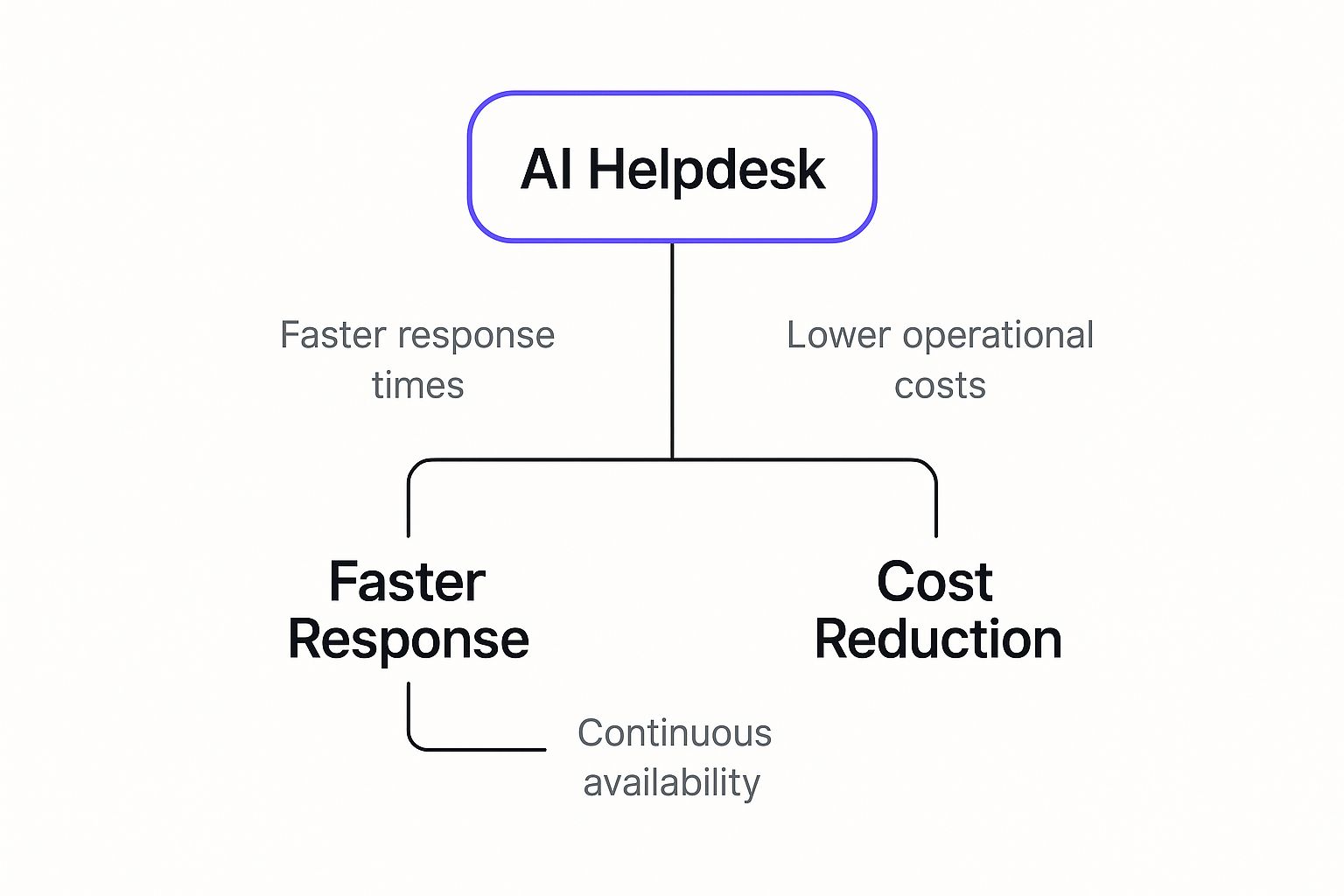
The visual makes it clear how a central AI helpdesk connects directly to faster responses, significant cost savings, and true 24/7 availability.
Robotic Process Automation: The Hands
Finally, we have Robotic Process Automation (RPA), which acts as the system’s “hands.” Once ML and NLP have figured out what's needed, RPA is what actually does the work. It’s built to handle repetitive, rule-based tasks with perfect accuracy, every single time.
Here’s how all three work together in a real-world scenario:
- A user asks for a password reset through a chat window (NLP).
- The system recognizes the request and confirms the user's identity based on past data (ML).
- A bot then carries out the password reset in the background and confirms it's done (RPA).
Together, these technologies transform a standard helpdesk into an intelligent, autonomous system. It resolves issues faster and, just as importantly, frees up your human agents to focus on the more complex, strategic work that truly requires their expertise.
Real-World Benefits of Integrating AI in Your Helpdesk
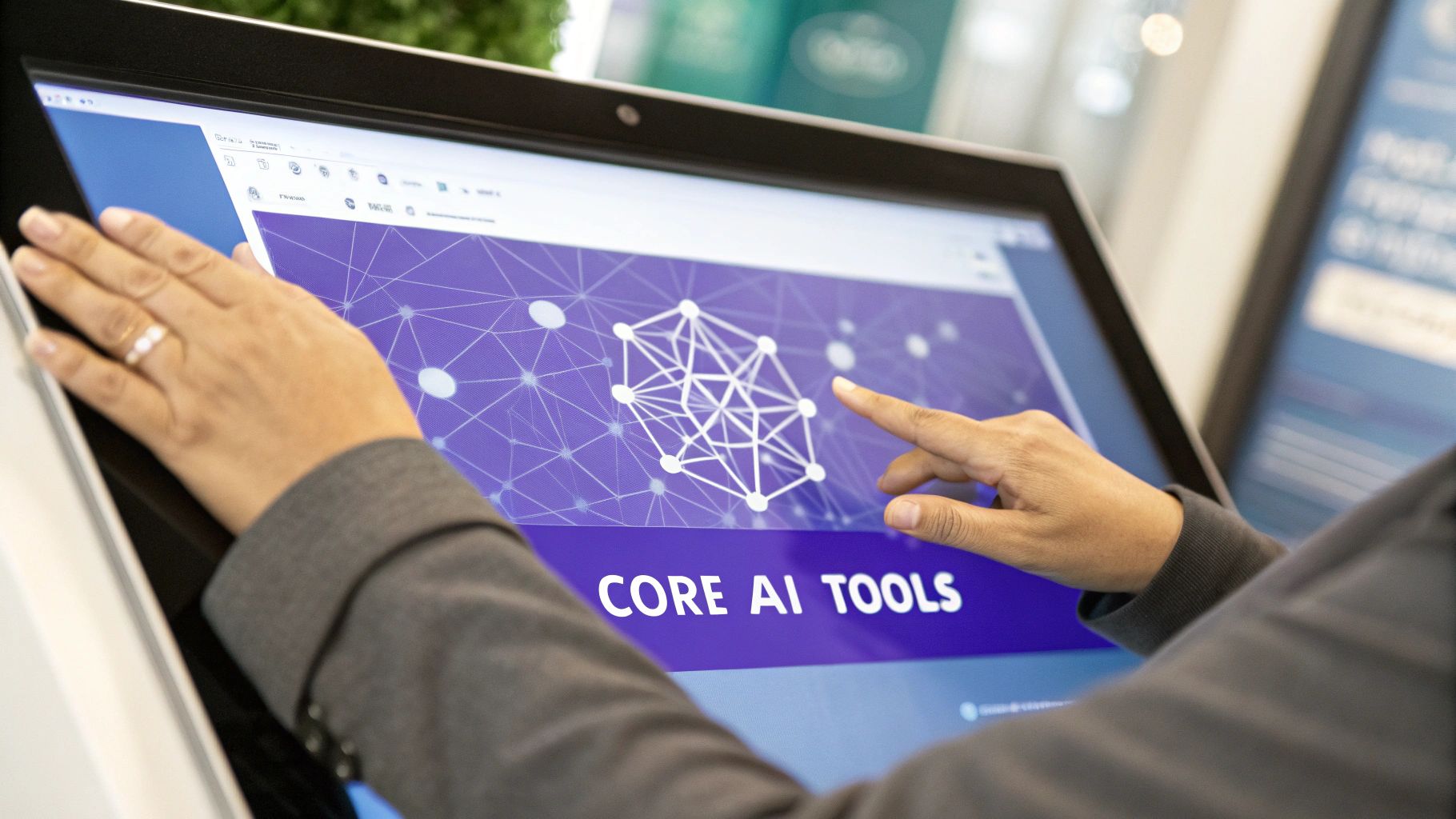
Let's move past the technical jargon for a minute. The real value of bringing AI into your helpdesk shows up in ways you can actually measure: lower costs, a more productive team, and a support experience that genuinely keeps people happy.
It’s about turning your helpdesk from a reactive cost center into a proactive, strategic part of your business.
Think about a typical IT support team drowning in a sea of repetitive tickets. Password resets, software access requests, and basic troubleshooting questions just keep coming. This kind of work burns out skilled agents and leaves employees stuck waiting for simple fixes.
Now, imagine that same team with an AI assistant. The AI instantly handles all that low-level noise, resolving common issues in seconds, 24/7. This simple change lifts a massive weight off the team's shoulders.
This isn't just about making things faster; it makes the entire support function better. Agents are no longer just closing tickets. They’re free to become real problem-solvers, tackling the complex, high-impact issues that actually need their expertise.
Radically Improved Productivity and Efficiency
The efficiency boost from AI isn't just a small bump—it's a massive leap. For example, AI-powered systems can resolve up to 30% of support tickets immediately, with zero human touch. That’s thousands of hours of productivity handed back to your employees and support agents.
Even better, generative AI tools have been shown to increase developer productivity by a staggering 55%, while conversational AI scripts can help tech support agents boost their issue resolution rates by an average of 14%. These aren't just numbers; they represent your team getting more done without burning out. You can find more stats on AI's productivity impact over at Atera.com.
The goal of helpdesk AI isn't to replace your valuable human agents. It's to empower them, turning them into a more effective, strategic force by automating the tedious tasks that hold them back.
A New Standard for User Support
When you bring AI into the mix, you're setting a new gold standard for the support experience. The benefits are clear and hit home for everyone involved.
- 24/7 Instant Support: Problems don’t follow a 9-to-5 schedule. AI offers round-the-clock help, so users get instant answers to common issues no matter the time zone or day of the week. Downtime and frustration drop immediately.
- Reduced Operational Costs: Every ticket an AI resolves on its own is one less ticket a human agent has to touch. This translates directly into significant cost savings by making your resource allocation smarter and lowering the cost of each interaction.
- Elevated Agent Morale: When you free your agents from mind-numbing, repetitive work, their job satisfaction skyrockets. They get to focus on engaging, challenging problems that make a real difference, which leads to better retention and a more motivated team.
By automating key processes, you can completely reshape your support operations. For a closer look at the "how," check out our guide on help desk automation.
Ultimately, helpdesk AI is a true game-changer, giving businesses the tools to deliver faster, smarter, and more cost-effective support.
Proven Use Cases for Helpdesk AI
While the benefits sound great on paper, the true power of helpdesk artificial intelligence really clicks when you see it in action. This is where we move from concepts to concrete applications that actually drive results. Businesses are using AI to solve real-world support challenges every single day, changing how their operations work from the ground up.
These aren’t futuristic ideas; they are practical tools being used right now. Let's dig into some of the most impactful use cases.
Intelligent Ticket Routing and Categorization
One of the biggest time-sucks in any helpdesk is the manual triage of incoming tickets. An agent has to read each request, figure out what it’s about, decide how urgent it is, and then pass it to the right person or department. It's a slow, inconsistent process that often creates a frustrating bottleneck.
Helpdesk AI automates this completely. Using machine learning and natural language processing, the system analyzes every new ticket the moment it arrives.
- Before AI: An agent spends hours each morning sorting through a queue of unassigned tickets, leading to slow first responses. A critical server issue might get buried under a pile of simple password reset requests.
- After AI: The AI instantly reads, categorizes, and prioritizes tickets. That critical server issue is immediately flagged as high-priority and routed to a specialized IT engineer, while the password resets are handled automatically—all within seconds.
This makes sure the most urgent issues get attention first and that tickets always go to the agent with the right skills to solve them, dramatically cutting down resolution times.
Proactive Problem Detection and Resolution
The best kind of support ticket is the one that never has to be created in the first place. This is where helpdesk AI shifts the model from reactive to proactive. Instead of just waiting for users to report a problem, the AI monitors systems to find and fix issues before they impact anyone.
AI can identify subtle patterns in system performance logs that signal an impending failure. This allows IT teams to address the root cause before users even notice a problem, preventing widespread disruption and frustration.
Imagine an AI noticing that memory usage on a specific server is slowly creeping up in a way that historically leads to a crash. It can automatically create a high-priority ticket for the infrastructure team with all the relevant data, letting them fix it during off-hours. This single action prevents dozens of employees from experiencing downtime the next morning.
AI-Powered Chatbots and Self-Service
For common, repetitive questions, nothing beats an AI-powered chatbot. These bots are the front line of your support, offering instant answers 24/7. They can handle a huge volume of simple requests, from "How do I reset my password?" to "Where can I find my payslip?"
- Chatbot Example: A new employee needs access to a specific software tool. Instead of creating a ticket and waiting, they ask the helpdesk chatbot. The bot confirms their identity, verifies their role allows access, and uses Robotic Process Automation (RPA) to grant the permission automatically.
Dynamic Knowledge Base Suggestions
A knowledge base is only useful if people can actually find the right answers. AI supercharges this by delivering relevant articles at just the right moment.
When an agent is working on a ticket or a user is typing a question into a portal, the AI suggests the most likely solution from the knowledge base. This cuts down on research time for agents and empowers users to solve their own problems without ever needing to speak to someone.
How to Implement Helpdesk AI Successfully
Bringing AI into your helpdesk isn't like flipping a switch. You can't just turn it on and expect magic. A thoughtful, phased approach is the only way to make sure the transition is smooth and actually delivers value without overwhelming your team. The goal is to make AI a powerful ally, not just another disruptive tool.
It all starts with a clear-eyed assessment. Don't get distracted by the flashiest AI features. Instead, look at your biggest support headaches. Are password resets eating up 25% of your team's time? Is ticket triage creating a huge backlog every single morning? Pinpoint the areas causing the most friction and volume. These are the perfect places to start.
Once you know what you're trying to fix, you can choose the right tools for the job. Not all helpdesk AI platforms are created equal. Some are brilliant at chatbot interactions, while others are masters of backend automation and ticket analysis. Your job is to align the tool with the specific pain point you’ve already identified.
Launch a Pilot Project to Prove Value
Before you go all-in, run a focused pilot project. This is your chance to test the technology in a controlled environment and build a solid business case with real data. A successful pilot doesn't just prove the return on investment; it gets key stakeholders genuinely excited about what's possible.
For example, a great pilot project could involve:
- Automating a single, high-volume ticket category. Pick something simple and repetitive, like software access requests.
- Setting clear success metrics. Track things like resolution time, the number of tickets deflected, and user satisfaction scores for that specific category.
- Gathering feedback from a small user group. See how employees and agents actually interact with the new system. This helps you spot friction points early on.
This approach minimizes risk and gives you concrete evidence of AI’s impact, making it much easier to justify a broader rollout.
Prepare Your Team for Change
The most critical part of any helpdesk artificial intelligence implementation is managing the human side of it. Your support agents are your greatest asset, and it's essential they see AI as a tool that enhances their skills, not a threat to their jobs.
AI should handle the machine-work, freeing up your talented human agents to do the people-work. Frame the change as an opportunity for them to focus on more complex, strategic, and rewarding problem-solving.
Proactively managing this change is vital, especially given how quickly AI is being adopted. Roughly 35% of businesses worldwide have already integrated AI systems, and nearly 90% are using AI to stay competitive. With global AI investments projected to hit around USD 200 billion by 2025, this technology is quickly becoming a standard operational tool. You can find more details on the growth of AI adoption at Fortune Business Insights.
Offer training that focuses on how to collaborate with AI, interpret its insights, and manage the more complex tickets it escalates. When your team understands how an AI help desk can make their jobs better, they become its biggest champions. By taking these measured steps, you can ensure your AI implementation is a success from day one.
The Future of Helpdesk Artificial Intelligence

When we look ahead, it’s clear that helpdesk artificial intelligence is moving far beyond just automating tickets. The trends gaining momentum point to a support ecosystem that isn’t just reactive, but truly predictive and autonomous. This shift is reshaping the future of work for IT and support teams everywhere.
The growth behind this evolution is staggering. Valued at USD 638.23 billion in 2024, the global AI market is projected to hit roughly USD 3,680.47 billion by 2034. That’s a compound annual growth rate of 19.20%, driven by intense adoption across every industry. You can dive deeper into the data on the explosive growth of the AI market at Precedence Research.
Investing in AI today isn’t just a nice-to-have; it's a foundational step for building a resilient, forward-thinking organization.
The Rise of Hyper-Automation
The next major leap is hyper-automation, where AI won't just handle a single task but will manage complex support workflows from start to finish. Picture a system that not only detects a server outage but also diagnoses the root cause, deploys a fix, verifies the solution, and closes the ticket—all without a human ever touching it.
This is worlds away from simple task automation. It’s about orchestrating multiple tools and processes to resolve intricate problems on their own.
Predictive Analytics for Proactive Support
The future of support is getting ahead of problems, not just reacting to them. AI-powered predictive analytics is set to become the standard, shifting the focus from fixing issues to preventing them in the first place. By sifting through massive datasets—system logs, user behavior, network traffic—AI can spot the subtle patterns that signal an impending crash or slowdown.
Instead of waiting for users to report a problem, the helpdesk of tomorrow will alert IT teams to potential issues before they ever impact productivity. This turns support from a fire-fighting unit into a strategic prevention force.
This proactive stance will be a game-changer for minimizing downtime and creating a more stable, reliable IT environment.
Generative AI for Personalized Content
Finally, generative AI is poised to completely change how support knowledge is created and shared. Forget static, one-size-fits-all knowledge base articles. Future systems will generate personalized, step-by-step guides on the fly, tailored to a specific user and their exact problem.
This ensures every user gets the most relevant and easy-to-follow information, dramatically improving the self-service experience and boosting first-contact resolution rates.
Common Questions About Helpdesk AI
When you start looking into helpdesk AI, it’s natural for some practical questions to pop up. Most businesses wonder what the real impact will be on their teams and what kind of resources it really takes to get started.
Let’s tackle a few of the most common questions to clear things up.
Will AI Replace Our Human Helpdesk Agents?
Nope. The goal of helpdesk AI isn't to replace your team, but to make them better. AI is fantastic at handling the high-volume, repetitive stuff—think password resets or basic "where do I find this?" questions.
This frees up your human agents to focus on complex problems that actually require critical thinking, empathy, and creative solutions.
Think of AI as a powerful assistant. It takes on the monotonous work, which makes your human team more efficient and valuable than ever. This partnership elevates their role from just closing tickets to becoming strategic problem-solvers.
Is Implementing Helpdesk AI Difficult or Expensive?
It doesn't have to be. While the cost and complexity can vary, many modern platforms now offer built-in AI features that are surprisingly easy to get up and running. You don't need a massive budget or a team of data scientists anymore.
A smart way to start is with a small pilot project. Pick one single, high-volume issue and automate it. This lets you prove the value with a quick win.
From there, the long-term savings from improved efficiency and a lower ticket volume often deliver a serious return on your initial investment.
Ready to see how an AI assistant can supercharge your support team? With Chatiant, you can build a custom AI agent trained on your own data in minutes. Start your free trial today and transform your helpdesk!
